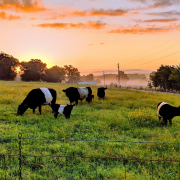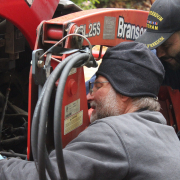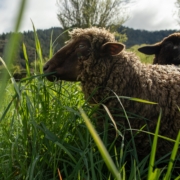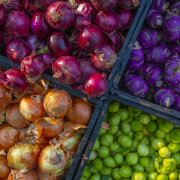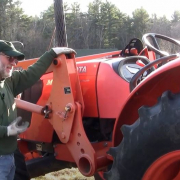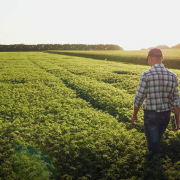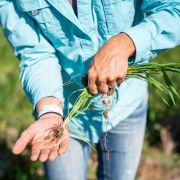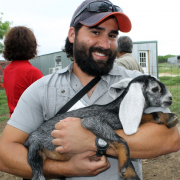Getting Started with Livestock
By Margo Hale, NCAT Southeast Regional Director, Armed to Farm Program Director, and Agriculture Specialist
My day begins with a hot cup of coffee and a quick check of our farm. What a thrill to find a new baby calf from our Belted Galloways, to watch the antics of our pig, to have my girls gather farm-fresh eggs, and to watch the goats grazing. Livestock bring life to the farm!
Then again, livestock can bring difficulty. The bull escaped; we need to return him to the pasture and fix the fence. The processor doesn’t have a slot for the pig, the price of chicken feed rises, and the goats get into mischief.
While I can’t imagine life without livestock, I recognize that they don’t fit on every farm or for every farm family. Let’s consider the benefits and some of the challenges of living with livestock.
Benefits of Livestock
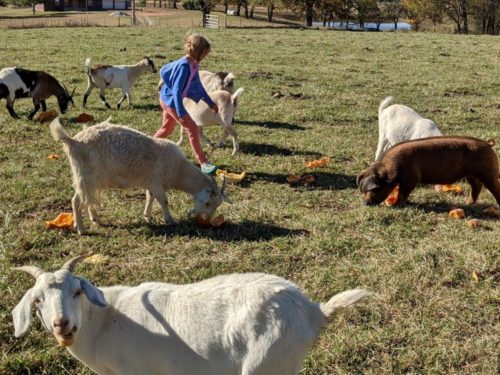
Livestock can turn your over-ripe or excess vegetables into meat. On the Hale farm, goats and pigs take care of the discarded Halloween pumpkins. Photo: Margo Hale, NCAT.
On our farm, and yours, livestock turn pasture and browse into healthy meat. Pasture-raised hogs and poultry need other feed as well, but the meat and eggs produced on pasture are healthier for our family and community. Those grazing animals improve the fertility of our land and boost soil health. And during the garden season our livestock “recycle” excess or over-ripe vegetables, turning waste into meat or eggs. Farms that already have a customer base will find that adding farm-raised meat or eggs can really boost sales and bring in new customers.
There are also many intangible, but real, benefits, as we have learned. Livestock are fun to watch and interesting to raise. They’re valuable for teaching children to be responsible, observant, and curious. They teach kids how science and nature work and how food is grown. These life-long lessons were given to me as a child, and it is satisfying to pass them on to my children, as well.
Assessing Resources
For our family, livestock are a perfect fit. Are they for you?
Before getting started with any enterprise, it is important to consider the goals you have for your farm, family, and lifestyle. How will livestock help you meet your farm goals? Your farm goals, including financial goals, will impact the livestock species you choose, your scale of production, and marketing streams.
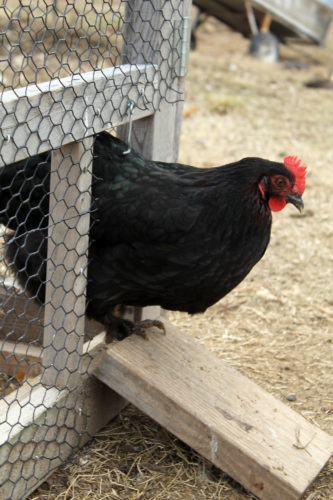
Chickens are easier to contain and need much less space than cattle, so they can be a good fit on small acreage. Photo: Robyn Metzger, NCAT.
Next, what are your available resources? Consider land, money, infrastructure, and time. Some enterprises lend themselves best to smaller acreages: poultry, rabbits, and bees take little space. Grazing livestock need more area so that you can protect soil and pastures and keep livestock healthy. If you have sufficient acreage to raise larger livestock, then the type of forages may influence your decisions. Woodlots are a good fit for hogs and goats, whereas farms with mostly grass pastures best suit sheep and cattle.
Another factor that influences your choice of enterprise is the money you have available to invest in livestock and infrastructure. You can start small with any enterprise, but some are easier and cheaper to contain, such as poultry and rabbits. Grazing livestock need a larger enclosure and are therefore more expensive to start. If there is existing infrastructure, that is very helpful. If not, you will need to budget funds for fence, water, and needed equipment. These up-front costs can be significant, but they are vital. You don’t want an angry phone call from your neighbor about your goats killing their fruit trees!
Having a way to deliver adequate quantities of water to your livestock is also imperative and can be tricky to figure out. In addition, livestock usually need supplementary feed. Poultry, rabbits, and hogs need grain, while grazing animals need hay in winter. Where can you source feed, for what price? Where can you store feed to keep it dry and protected from livestock and rodents? Feed goes into the budget, as all feed costs are paid before you get meat to sell.
Shelter may be an issue. In our moderate climate and with our choice of hardy cattle and goats, we rarely need shelter. However, baby goats born in a cold rain will suffer. If they get too chilled to nurse, they will die. Therefore, we need a plan for circumstances where the livestock do need shelter.
Local markets and processing may also influence your choice. Pasture-raised eggs are always popular, but what is the selling price for a dozen in your area? Can you make money selling at that price, given your feed cost? Similarly, meat enterprises may be feasible or not, depending on the local prices, processing, and feed costs. You will need to do some homework, investigating the local situation and plugging the numbers into a budget to see if the enterprise makes sense. The sample budgets in ATTRA’s Small Scale Livestock Production publication can serve as a starting point. Also see publications on the ATTRA livestock page about whatever enterprise you are considering. Know before you begin what you can produce and for what cost—this knowledge can help guide your choice of livestock enterprise and save your family from a costly mistake.
Time is a precious resource and your farm setup and the enterprises you choose must take this into consideration. Our family includes two children and two full-time, off-farm jobs; therefore, one of our goals is to have easy-to-manage enterprises that don’t take much time. That is important when we need to leave the farm; also, our farm sitter needs the chores to be low-stress and easy to complete. We accomplish that by being intentional in our enterprise selection, infrastructure setup, and our management. Don’t set yourself up for disappointment by taking on more than you can easily manage in the time you have available.
In next week’s blog, I will share some of the strategies and infrastructure we use on our farm to save time and money. Stay tuned!
Learning More
No matter what livestock you choose, it is best to start small. Learn with a few animals so your mistakes—and you will make mistakes—won’t be as costly. Continuously monitor your enterprise and adjust as needed. Remember to keep your farm and family or lifestyle goals in mind. Is this livestock enterprise helping you meet those goals? For example, while our sheep were profitable, we found that we didn’t enjoy raising them and they took too much time. In contrast, my coworker, NCAT Livestock Specialist Linda Coffey, found that sheep worked better than meat goats on their farm. Their customers wanted lamb and the sheep made best use of the pastures. We sold our sheep, and Linda sold the meat goats. Both of us are happier.
There is much to learn about raising and marketing livestock. I would suggest finding a mentor who you can learn from and lean on for advice. Connecting with local producer or grazing groups is a great way to find a mentor. ATTRA has many resources (linked below), and our Livestock Specialists are available to answer questions and talk with you about these considerations. Linda and I will be discussing species specific considerations in an upcoming podcast. Send your questions to us at margoh@ncat.org and lindac@ncat.org.
ATTRA Resources
Getting Started with Livestock Podcast
Small Scale Livestock Production
ATTRA Livestock and Pasture resources
Livestock as a Tool: Improving Soil Health, Boosting Crops

